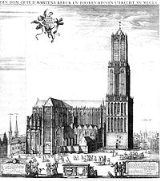
Cathedral of Saint Martin, Utrecht
Encyclopedia

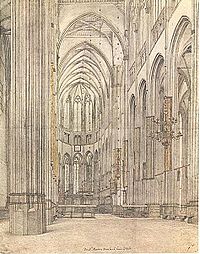
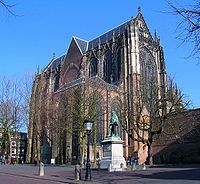
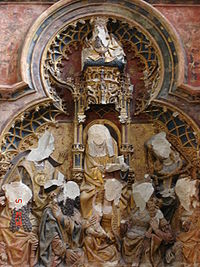
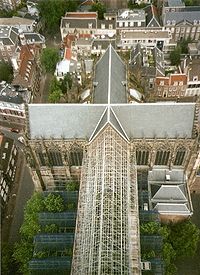
Cathedral
A cathedral is a Christian church that contains the seat of a bishop...
of the diocese
Diocese
A diocese is the district or see under the supervision of a bishop. It is divided into parishes.An archdiocese is more significant than a diocese. An archdiocese is presided over by an archbishop whose see may have or had importance due to size or historical significance...
of Utrecht during the Middle Ages
Middle Ages
The Middle Ages is a periodization of European history from the 5th century to the 15th century. The Middle Ages follows the fall of the Western Roman Empire in 476 and precedes the Early Modern Era. It is the middle period of a three-period division of Western history: Classic, Medieval and Modern...
. Once the Netherland's largest church, dedicated to Saint Martin of Tours, it is one of the country's two pre-Reformation cathedrals, along with the cathedral in Middleburg, Province of Zeeland. It has been a Protestant church since 1580. The building is the one church in the Netherlands that closely resembles the classic Gothic
Gothic architecture
Gothic architecture is a style of architecture that flourished during the high and late medieval period. It evolved from Romanesque architecture and was succeeded by Renaissance architecture....
style as developed in France
France
The French Republic , The French Republic , The French Republic , (commonly known as France , is a unitary semi-presidential republic in Western Europe with several overseas territories and islands located on other continents and in the Indian, Pacific, and Atlantic oceans. Metropolitan France...
. All other Gothic churches in the Netherlands belong to one of the many regional variants.
Unlike most of its French predecessors, the Dom Church has only one tower, the 112 m (368 ft) high Dom Tower
Dom Tower of Utrecht
The Dom Tower of Utrecht is the tallest church tower in the Netherlands, at 112.5 metres in height, and the Gothic-style tower is the symbol of the city. The tower was part of the Cathedral of Saint Martin, Utrecht, also known as Dom Church, and was built between 1321 and 1382, to a design by...
, which is the hallmark of the city.
History
The first chapel dedicated to Saint Martin in Utrecht was founded around 600 by Frankish clergy under the patronage of the Merovingian kings but was destroyed during an attack of the FrisianFrisians
The Frisians are a Germanic ethnic group native to the coastal parts of the Netherlands and Germany. They are concentrated in the Dutch provinces of Friesland and Groningen and, in Germany, East Frisia and North Frisia, that was a part of Denmark until 1864. They inhabit an area known as Frisia...
s on Utrecht shortly thereafter. The site of this first chapel within Utrecht is unknown. Saint Willibrord (died 739), the Apostle to the Frisians, established a second chapel devoted to Saint Martin on (or close to) the site of the current Dom. This church was destroyed by the Normans in the 9th century during one of their many raids on Utrecht, but was reconstructed by Bishop Balderik in the 10th century. During this period St. Martin's came to be the principal church (or minster) of Utrecht, see of the bishop. The church had its own small territorial close (known as an "immunity") and was led by a chapter of Canons
Canon (priest)
A canon is a priest or minister who is a member of certain bodies of the Christian clergy subject to an ecclesiastical rule ....
, who generally belonged to the nobility.
The church was repeatedly destroyed by fires and then rebuilt. A church in Romanesque
Romanesque architecture
Romanesque architecture is an architectural style of Medieval Europe characterised by semi-circular arches. There is no consensus for the beginning date of the Romanesque architecture, with proposals ranging from the 6th to the 10th century. It developed in the 12th century into the Gothic style,...
style was built by Adalbold
Adalbold II of Utrecht
Adalbold II of Utrecht was a bishop of Utrecht .He was born probably in the Low Countries, and received his education partly from Notker of Liège. He became a canon of Laubach, and apparently was a teacher there...
, Bishop of Utrecht, and consecrated in 1023. This building, also known as Adalbold's Dom, was partially destroyed in the big fire of 1253 which ravaged much of Utrecht, leading Bishop Hendrik van Vianen to initiate the construction of the current Gothic
Gothic architecture
Gothic architecture is a style of architecture that flourished during the high and late medieval period. It evolved from Romanesque architecture and was succeeded by Renaissance architecture....
structure in 1254. The construction of the gothic Dom was to continue well into the 16th century. The first part to be built was the choir. The Dom Tower was started in 1321 and finished in 1382. After 1515, steadily diminishing financing prevented completion of this building project, of which an almost complete series of building accounts exists. In 1566, the Beeldenstorm
Beeldenstorm
Beeldenstorm in Dutch, roughly translatable to "statue storm", or Bildersturm in German , also the Iconoclastic Fury, is a term used for outbreaks of destruction of religious images that occurred in Europe in the 16th century...
or Iconoclast Fury swept across much of the Low Countries
Low Countries
The Low Countries are the historical lands around the low-lying delta of the Rhine, Scheldt, and Meuse rivers, including the modern countries of Belgium, the Netherlands, Luxembourg and parts of northern France and western Germany....
, justified by the Calvinist belief that statues in a house of God were idolatrous images which must be destroyed. As a result, many of the ornaments on both the exterior and interior of the Dom were destroyed.
In 1580 the city government of Utrecht handed the Dom over to the Calvinists in the city. From then on Protestant services were held in the Dom with one brief exception during the French invasion of the Netherlands in 1672/1673, when Catholic masses were again held in the old cathedral. A year after the French retreat, in August 1674, the still unfinished and insufficiently supported nave collapsed during a thunderstorm. Over the subsequent centuries, much of the enormous building fell into further neglect. The pitiable state of the Dom led to some small restoration activities in the nineteenth century, followed by major renovations in the early twentieth century with the aim of returning the Cathedral to its original state. However, the nave was never rebuilt.
The Catholic Church of the Netherlands remained strong within Utrecht following the Reformation but was obliged to worship discretely in hidden chapels (schuilkerken). One of these chapels, St. Gertrude's, later became the principal cathedral of the Old Catholic
Old Catholic Church
The term Old Catholic Church is commonly used to describe a number of Ultrajectine Christian churches that originated with groups that split from the Roman Catholic Church over certain doctrines, most importantly that of Papal Infallibility...
archbishop of Utrecht.
When in 1853 the Roman Catholic Church
Roman Catholic Church
The Catholic Church, also known as the Roman Catholic Church, is the world's largest Christian church, with over a billion members. Led by the Pope, it defines its mission as spreading the gospel of Jesus Christ, administering the sacraments and exercising charity...
re-established its episcopal hierarchy in the Netherlands, the former St. Catherine's church of the Carmelites was turned into the new Catholic cathedral of Utrecht.
The church today
What remains of St. Martin's today are the choir, the transept and the Dom Tower. The central nave of the cathedral which collapsed in the storm of 1674 is now a square with large trees, the Domplein. Stones in various colours indicate in the pavement the original outlines of the church.In 2004, 750 years after construction began, the collapsed parts were temporarily rebuilt in scaffolding material. The scaffolding has since been taken down.
Burials and memorials in the Dom
Utrecht was an important city in the western Holy Roman EmpireHoly Roman Empire
The Holy Roman Empire was a realm that existed from 962 to 1806 in Central Europe.It was ruled by the Holy Roman Emperor. Its character changed during the Middle Ages and the Early Modern period, when the power of the emperor gradually weakened in favour of the princes...
and had particularly close links to the imperial Salian dynasty
Salian dynasty
The Salian dynasty was a dynasty in the High Middle Ages of four German Kings , also known as the Frankish dynasty after the family's origin and role as dukes of Franconia...
. In the early Middle Ages the Holy Roman Emperor was always an honorary Canon of the Dom. The Emperor Conrad II and the Emperor Henry V both died in Utrecht in 1039 and 1125 respectively. Their bowels and hearts were interred in the Dom of Utrecht. The modest "Emperors' stones" (keizerssteentjes) in the floor of the choir of the Dom are a reminder of this fact.
The only medieval tomb of importance to remain relatively unscathed in the Dom is that of Bishop Guy of Avesnes
Guy of Avesnes
Guy van Avennes was Bishop of Utrecht from 1301 to 1317.-Family:He was descended from an important Hainaut family, the House of Avesnes...
(also known as Gwijde van Henegouwen), the brother of John II, Count of Holland
John II, Count of Holland
John II of Avesnes was the oldest son of John I of Avesnes and Adelaide of Holland.-History:John II was Count of Hainaut from 1280 to his death, succeeding his grandmother, Margaret II...
and Hainaut, who was bishop from 1301 until his death in 1317.
There are many other beautifully carved burial slabs and memorials in the cathedral. Of particular note is the monumental cenotaph, which contained the heart of Bishop Joris of Egmond (died 1559).

